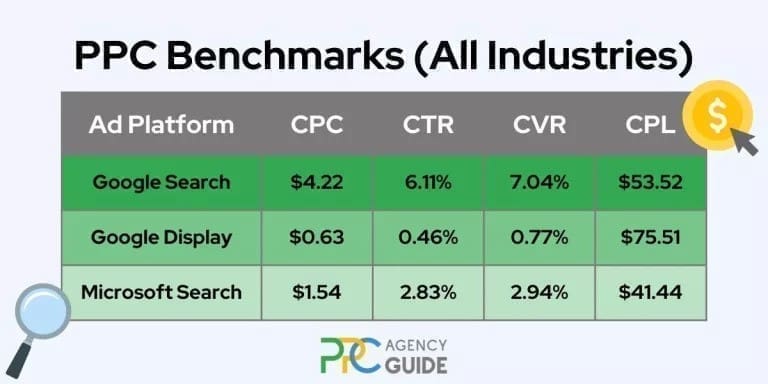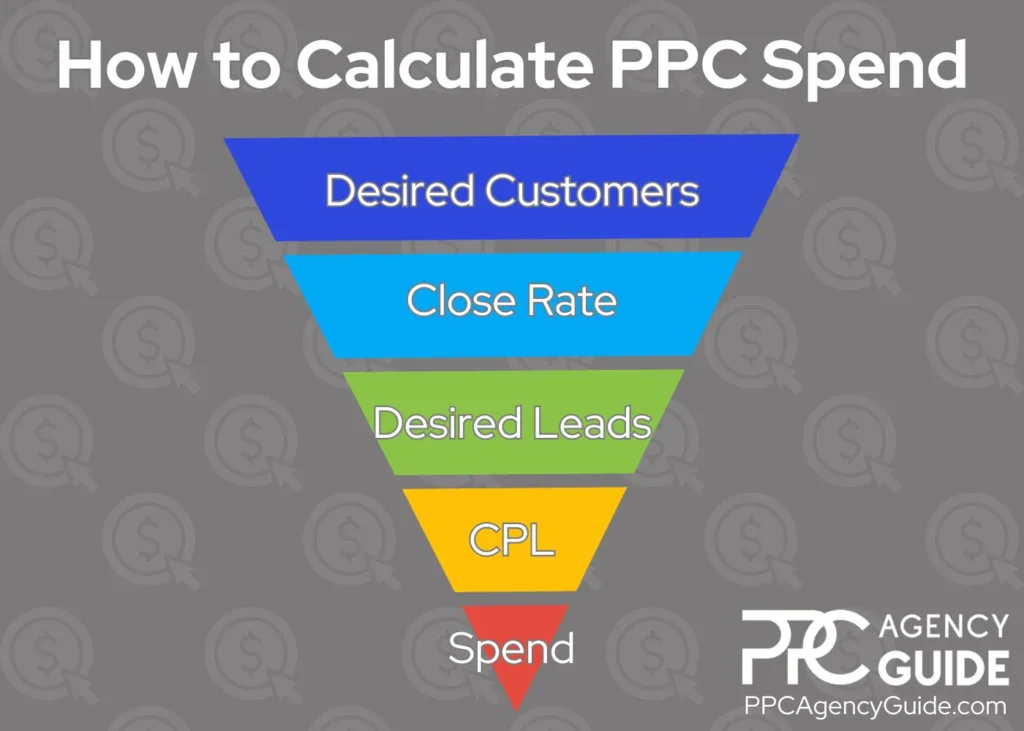
Worldwide digital ad spend is expected to hit nearly $700 billion in the coming year, per Statista. Given that Google Ads generate $2 for every $1 spent, the platform reports, brands can expect to bring in $1.4 trillion from their advertising.
Of course, not everyone will achieve the same return on investment (ROI). Performing a pay-per-click (PPC) strategy refresh can help ensure you do. On this page, we’ll walk you through evaluating your results and setting up a new-year PPC strategy that gets you the results you need.
Evaluate Your Past Year’s PPC Performance

Before you update your online advertising strategies, take stock of how your campaigns performed last year. Our PPC Benchmark Report covers metrics to meet by industry, platform, and ad type, so it’s easy to see if your ad performance is on par with competitors. It’s also helpful to compare your results year-on-year. That way, you can see which areas are underperforming and focus on them in your new year PPC strategy to boost ROI.
Cost Per Click (CPC)
CPC refers to the amount you pay each time someone clicks your ad. A lower CPC is generally better, though quality is also a concern. For instance, you might have a low CPC because you’re bidding on keywords that others aren’t. However, if those clicks don’t become customers because the keyword is irrelevant, you’ll still want to improve your keyword selection even though it increases your CPC.
With that said, overall CPC benchmarks are:
- Google Search: $4.22
- Google Display: $0.63
- Microsoft Search: $1.54
Clickthrough Rate (CTR)
CTR refers to the percentage of your ad viewers who actually click the ad. A higher CTR typically means your ads are relevant to readers and you provide them with a compelling reason to click.
Average CTRs across all industries are:
- Google Search: 6.11%
- Google Display: 0.46%
- Microsoft Search: 2.83%
Conversion Rate (CVR)
Each time the user completes the action you want, it’s counted as a conversion. Ergo, your CVR is the percentage of people who clicked the ad that took your desired action. A higher number is better here, too.
Average CVRs are:
- Google Search: 7.04%
- Google Display: 0.77%
- Microsoft Search: 2.94%
Cost per Lead (CPL)
A final metric to watch is your CPL, or how much each conversion costs your business. While lower is generally better, brands should be cautious of focusing exclusively on a low CPL, as it often leads to underbidding and results in a loss of new leads.
CPL averages are:
- Google Search: $53.52
- Google Display: $75.51
- Microsoft Search: $41.44
Set PPC Goals for the New Year
Generally speaking, PPC goals fit into four main categories:
- Building brand recognition
- Encouraging brand consideration
- Generating leads and sales
- Boosting loyalty and repeat sales
Find out your company-wide and overall marketing goals for the year, then develop PPC goals to help your brand meet them. Use the SMART goal method, which involves creating specific, measurable, attainable, relevant, and time-bound goals.
Establish Your PPC Key Performance Indicators (KPIs)
If you’re stuck on how to make your SMART goal measurable, try to find a way to tie it back to a standard KPI. That way, you can measure your success throughout the year and make changes if you’re not on track to meeting your goals.
- Cost per click (CPC)
- Clickthrough rate (CTR)
- Conversion rate (CVR)
- Cost per lead (CPL)
- Cost per action (CPA)
- Return on ad spend (ROAS)
- Ad Quality Score
Leverage Innovative PPC Tactics for the New Year
Google ads updates have done away with tools like similar audiences and expanded text ads. The platform also forced everyone to move from Universal Analytics to Google Analytics 4. But, in exchange, we’ve gotten many PPC automation advancements and new tools to use.
Performance Max (PMax)
Google’s PMax campaigns leverage AI and automation to simplify ad management and boost conversions. You provide specific inputs, and Google leverages them to advertise for your business on:
Voice Search
Three-quarters of families are expected to own a smart speaker by the end of the coming year, SerpWatch reports. Voice searches powered by Google Assistant, Apple’s Siri, Amazon’s Alexa, and the like are expected to grow 50 to 60 percent as a result. Considering that nearly half of all users search for local businesses every day, and three-quarters do so at least once per week. To ensure your PPC campaigns are ready for this wave:
- Use long-tail keywords. People use longer phrases when they speak as opposed to typing. For instance, someone might type the phrase “document preparation Los Angeles” but speak “legal document preparation services in Los Angeles.”
- Optimize for questions. Voice users are more likely to use phrases that begin with “who,” “what,” “when,” “why,” and “how.”
- Use natural language. Consider the differences in the word choices when people speak. For instance, a typed search might be “office supply store for businesses,” while a spoken search might be “office supply store that serves businesses.”
- Focus on local. Including phrases like “in Los Angeles” or “near Los Angeles” in your keyword strategy is ideal, though you may also want to consider landmarks people might use to search. For instance, “legal document preparation services near Anaheim Convention Center.”
Video and Audio Ads
The popularity of platforms like TikTok has boomed and shows no sign of slowing down. This is an excellent time to experiment with the platform if your audience leverages it, though bear in mind that it has a minimum daily budget of $50 and minimum ad spend of $500, so it’s something you’ll need to plan for.
As a result of the video boom, most platforms now offer some form of reel-style ads. Others are experimenting with different formats. For instance, you can now place audio ads on YouTube to target people listening to music and podcasts.
While these specific new options might not speak to your personas, experimenting with different platforms and ad types should be part of your overall new year PPC strategy.
Budget and Allocate Resources for PPC

The next step is to ensure you have the budget to enact your new year PPC strategy. A simple approach to setting your PPC budget is to work backward, starting with your goal, and then use your own metrics to calculate how much it will reach to achieve it.
Be careful not to shortchange yourself by setting the budget too low. Businesses often underestimate their customer lifetime value (CLV), which is the total money a customer brings in over their lifetime. For instance, investing $300 when acquiring a customer might sound like a lot. However, that $300 is worthwhile if you earn $600 from them during their time with you.
Monitor and Optimize
Ensure your new year PPC strategy includes time each week to review campaign performance and perform optimization tasks and time each month and quarter to evaluate your strategy and make changes as needed.
Get Help with Your New Year PPC Strategy
Setting up and maintaining PPC campaigns can be complicated, especially as the tools and technology continue to shift. An experienced PPC agency can leverage a mix of tested strategies and innovation to ensure you get maximum ROI from your campaigns. To learn more or get started, request a complimentary consultation.


















